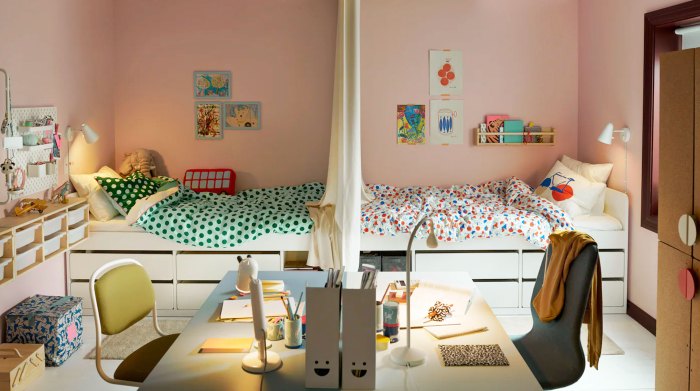How to decorate a shared room – When it comes to decorating a shared room, there are several important factors to consider in order to create a space that is both functional and aesthetically pleasing. Whether you are sharing a room with a sibling, a roommate, or a partner, it is essential to find a balance between individual style and shared preferences.
When it comes to decorating your dining room table, there are endless possibilities to showcase your style and creativity. From elegant centerpieces to coordinating table linens, the key is to create a welcoming and inviting atmosphere for your guests. You can mix and match different elements like fresh flowers, candles, or seasonal decor to add a personal touch. For more ideas on how to decorate your dining room table, check out how do you decorate your dining room table.
Communicate and Compromise
One of the most important aspects of decorating a shared room is open communication and compromise. Sit down with your roommate or partner and discuss your individual styles, preferences, and must-haves for the space. Find common ground and be willing to make compromises in order to create a harmonious living environment.
Define Separate Spaces

It is crucial to define separate spaces within the room to ensure privacy and personalization. Consider using room dividers, area rugs, or curtains to create individual zones for sleeping, studying, and relaxing.
Choose a Neutral Color Palette: How To Decorate A Shared Room

Opting for a neutral color palette can help create a cohesive look in a shared room. Neutral colors such as white, beige, and gray provide a versatile backdrop that can be easily personalized with pops of color through bedding, throw pillows, and wall art.
Maximize Storage
Storage is key in a shared room to keep clutter at bay and maintain a sense of organization. Invest in multifunctional furniture such as beds with built-in drawers, floating shelves, and storage ottomans to maximize space and keep belongings tidy.
Personalize with Decorative Accents
Add a personal touch to the shared room with decorative accents that reflect your individual style. Incorporate elements such as artwork, plants, throw blankets, and decorative pillows to infuse personality and warmth into the space.
Respect Each Other’s Boundaries
Respect is essential in a shared room setting. Be mindful of each other’s boundaries, personal space, and belongings. Establish ground rules for shared responsibilities such as cleaning, organizing, and noise levels to maintain a harmonious living environment.
What Does It Mean to Decorate a Shared Room?
Decorating a shared room involves creating a cohesive and personalized space that reflects the unique styles and preferences of each occupant while also fostering a sense of unity and harmony. It requires open communication, compromise, and creative solutions to maximize space and functionality.
Known Solutions for Decorating a Shared Room
Known solutions for decorating a shared room include defining separate spaces, choosing a neutral color palette, maximizing storage, personalizing with decorative accents, and respecting each other’s boundaries. These strategies help create a balanced and inviting environment that meets the needs and preferences of all occupants.
Detailed Information on Decorating a Shared Room
When decorating a shared room, it is important to consider the individual needs and preferences of each occupant while also finding common ground and creating a cohesive look. Communication, compromise, and creativity are key in designing a space that is functional, stylish, and harmonious.
Describing in Depth How to Decorate a Shared Room
To decorate a shared room effectively, start by discussing with your roommate or partner to establish a shared vision for the space. Consider the layout, functionality, and aesthetic preferences of each occupant to create a design that reflects both individuality and unity. Define separate zones for sleeping, studying, and relaxing to ensure privacy and personalization. Choose a neutral color palette as a versatile backdrop for personal touches and accents.
Maximize storage with multifunctional furniture and organizational solutions to keep the room tidy and clutter-free. Personalize the space with decorative accents that showcase your unique style and personality. Lastly, maintain respect, communication, and cooperation to foster a harmonious living environment.
Conclusion
Decorating a shared room requires careful planning, communication, and creativity to create a space that is both functional and stylish. By following the tips and strategies Artikeld in this article, you can design a shared room that reflects the unique personalities of each occupant while also fostering a sense of unity and harmony.
When it comes to decorating your dining room table, there are endless possibilities to showcase your style and creativity. You can start by choosing a theme or color scheme that reflects your personality. Adding a beautiful tablecloth, elegant dinnerware, and a centerpiece can instantly elevate the look of your table. To add a personal touch, consider incorporating fresh flowers or candles.
For more tips on how to decorate your dining room table, check out how do you decorate your dining room table.
FAQs
1. How can I personalize a shared room without compromising on style?

To personalize a shared room without compromising on style, incorporate decorative accents such as artwork, plants, throw pillows, and rugs that reflect your individual taste while also complementing the overall aesthetic of the space.
2. What are some storage solutions for maximizing space in a shared room?
Storage solutions for maximizing space in a shared room include beds with built-in drawers, floating shelves, storage ottomans, and closet organizers. These options help keep belongings organized and out of sight, minimizing clutter.
3. How can I define separate spaces in a shared room?
To define separate spaces in a shared room, consider using room dividers, area rugs, curtains, or furniture arrangement to create distinct zones for sleeping, studying, and relaxing. This helps maintain privacy and personalization for each occupant.
4. What are some tips for choosing a neutral color palette for a shared room?
When choosing a neutral color palette for a shared room, opt for versatile colors such as white, beige, and gray that serve as a backdrop for personalization. Add pops of color through bedding, throw pillows, and accessories to infuse personality and warmth into the space.
5. How important is communication in decorating a shared room?
Communication is essential in decorating a shared room as it helps establish a shared vision, resolve conflicts, and ensure that the design reflects the preferences of all occupants. Open and honest communication fosters cooperation, respect, and harmony in a shared living space.










